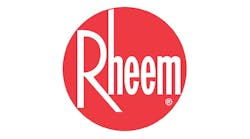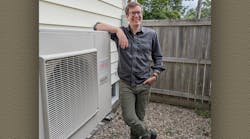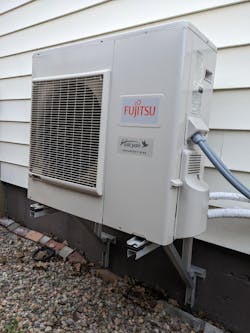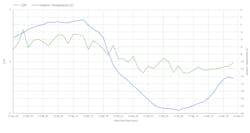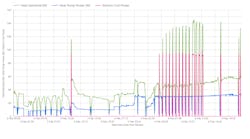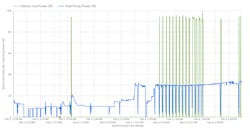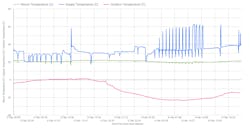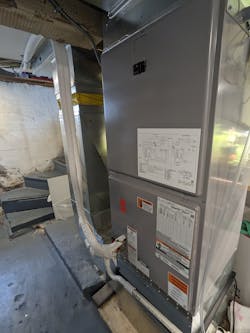Latest from Green
Sponsored
By David McMichael
Few homeowners have interest in collecting detailed energy use and heating system performance data at their residence. Even fewer are qualified to do so.
Ryan Kelly, however, is a research and development engineer for Efficiency Nova Scotia. He manages a team that runs pilot projects impacting efficiency programs in the province. More specifically, he helps determine how best to retrofit heat pump technology to existing ducted systems.
Kelly owns a 1,400 square foot, 90-year-old house in Halifax. The home was originally heated with an oil-fired furnace, but in the 1990s, the previous owner had abandoned the furnace in favor of electric resistance baseboard upstairs, and an ETS (Electric Thermal Storage) unit downstairs. The five-inch round ductwork was still in use because a unitary air conditioner had been added.
Kelly hired Sunshine Renewable Energy to install a 2-ton, 19-SEER (Region IV HSPF 10.7) ducted mini-split heat pump to replace the existing heating and cooling systems. The company is one of the largest Fujitsu dealers in Canada.
Richard Ross, who owns Sunshine Renewable Energy, immediately saw the potential to repurpose the existing ductwork by installing a single-zone Airstage H-Series heat pump and ducted air handler. The 60-person solar and HVAC company completed the retrofit in a single day.
“We replace a lot of oil furnaces and electric baseboard with mini-splits,” said Ross. “Our focus is energy efficiency, electrification, helping customers with rebates, and maximizing their return on investment. This job, like many others, qualified for Canada’s Greener Homes Grant. Between federal and provincial programs, there are over $10,000 in rebates and zero percent financing for 10 years.”
Data Collection
Armed with that information, his own professional experience, and the tools needed to conduct data collection, Kelly set up a variety of tests and monitoring criteria.
“I installed monitoring equipment at the panel to measure power and energy at the breakers for the heating equipment,” said Kelly. “Continuous, direct measurements of airflow are not practical. To estimate airflow indirectly, I built a curve from spot measurements of fan motor current as well as airflow using a hot-wire anemometer. Fan current is then measured continuously and that curve is used to estimate instantaneous airflow. Temperature and humidity sensors were installed on both the supply and return sides of the air handler mounted in a basement utility room. Outdoor temperature and humidity sensors were also installed.”
Kelly’s job often relies on revenue-grade power measurements, but this personal project was different.
“I wanted to use open-source, inexpensive, and readily available resources wherever possible,” he explained. “For example, a Raspberry Pi and ESP as hardware interfaces; basic CTs and temperature sensors; and everything analyzed, visualized, and recorded in Home Assistant”.
“We often characterize heat pump performance on an annual basis or under a specific set of conditions, but it’s insightful to open up your phone and check what’s happening right now,” he continued. “For example, when it’s particularly cold, windy, raining and so on.”
Data from half of the 2022/2023 heating season was archived, but the most telling numbers were collected during a mid-February record-breaking cold snap.
As a maritime province, Nova Scotia’s winters are milder (albeit wetter) than most of Canada. The average February high temperature in Halifax is 0°C (33°F), with an average low temperature of -8°C (17°F).
“When I saw the forecast calling for -24°C (-11°F), I knew I had a unique opportunity to capture data that would test the low temperature performance of the heat pump,” said Kelly. “I double checked the monitoring equipment and left the thermostat at 21°C (70°F).”
Real World Performance
The expectation was that the heat pump would turn off and the 9 kW backup electric coil in the air handler would run for a considerable portion of the cold snap. What actually happened was much different.
When temperatures plummeted, reaching a low of -21°C (-8°F), the heat pump stayed on. It operated at maximum capacity during the coldest periods. Both the COP (coefficient of performance) and total capacity reached similar levels to what is outlined in Fujitsu’s engineering manual, even at the lowest temperatures: 1.65 and 5.3 kW, respectively. Considering that the home is an uncontrolled environment, these numbers were remarkable.
“The electric coil came on briefly during the coldest period, but on a full-year basis, this is a rare occurrence,” said Steve Shellnutt, outside sales at Master Group, who learned the results of Kelly’s data collection shortly after the severe cold had passed. Sunshine Renewable Energy has an eight-year relationship with the reps at Master Group’s Dartmouth branch.
Generally, Shellnutt takes an active role in educating both the installer and customer about the low temperature performance of Fujitsu’s heat pump systems. On this application, that wasn’t necessary. Both the installer and the homeowner were well aware that modern mini-splits are suitable for cold climates.
“It’s possible that a 2.5-ton unit would have kept up without having to rely on backup, but it’s likely not worth the additional cost for the larger unit, considering the overall fraction of time that backup was needed,” continued Shellnutt.
Interestingly, the fan stayed on “low” nearly the entire time. When retrofitting a heat pump to ductwork designed to operate at high supply air temperatures—such as an oil-fired furnace—there’s potential for velocity noise from the fan having to operate at a higher speed. This didn’t happen. The heat pump capacity varied accordingly, increasing supply air temperatures as needed, with return air temperatures remaining consistent.
Conclusive testimony
“I wasn’t shocked by the results,” said Kelly. “It was consistent with the engineering manual described for COP and available capacity. We’ve seen that before, in mini-split field trials conducted on Prince Edward Island, which has a similar climate. Those tests yielded similar results.”
“It’s important to note that the ambient temperatures that Ryan captured are record-setting for Nova Scotia, and that the heat pump isn’t oversized,” said Shellnutt. “That provides conclusive testimony that these heat pumps are applicable to even colder climates. When sized correctly, these systems are fully capable of providing efficient heating capacity where very low temperatures occur more frequently.”
Because the energy consumption of the old, electric resistance heating system was monitored prior to the retrofit, a regression analysis on energy consumption data collected pre- and post-installation allowed for a weather-normalized estimate of energy savings. Using a baseline temperature of 18°C (64°F) and historical temperatures from the weather station nearest Kelly’s home, a typical year sees about 3,600 HDD (Heating Degree Days). Based on the observed performance of the heat pump, a 3,600 HDD year would result in energy savings of 8,700 kWh or $1,400 assuming $0.16/kWh, the current electricity rate in Nova Scotia.
David McMichael is a copy and content writer who specializes in digital content. He currently works as Digital Marketing Specialist at The Master Group, based out of Vaughan, ON.

